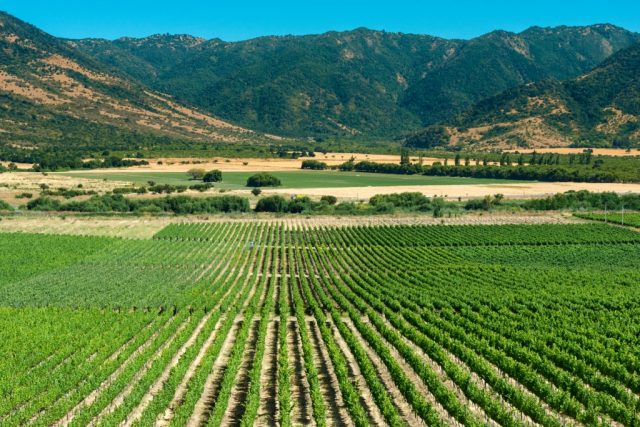Wine made in Chile, among the most popular in the world, inspires tremendous pride among Chileans. On the market shelves, beside Merlot and Sauvignon, one would undoubtedly find a lot of Carménère. Now, every grape has its history, and that’s one of the things that add to the charm of a wine, but the story of Carménère is puzzling indeed.
The grape was brought to the wine vineyards of Bordeaux to be raised with its distant relative Merlot, and although cared for and loved, it ended up extinct in Europe until it found fame and fortune far away from home, in Chile. It is thought to have been brought there from France during the late 19th century with the Chilean growers believing these vines were Merlot.
The name “Carménère” has its roots in the French word carmin, which means crimson and refers to the crimson color of the leaves in fall. Carménère is one of the original six red grape varieties grown in the Bordeaux region of southern France, along with Merlot, Cabernet Sauvignon, Cabernet Franc, Petit Verdot, and Malbec. Oenologists believe that this sort of grape originated in Spain and was brought to Italy by the Romans, who also transported it to the Médoc area of Bordeaux.

The Carménère grape endured and could be found throughout Europe. But stocks in the Graves area of Bordeaux were wiped out by a fungal disease, and then in 1867 a plague of the parasitic bug phylloxera attacked the vines in the whole of France. It spread through the European soil, causing massive destruction of the vineyard crops. When the epidemic subsided, the vignerons grafted only the stronger and more resistant vines. Carménère was particularly badly affected by the phylloxera and was subsequently so hard to find that people believed it to be extinct.
As the years passed, many Spanish, Italian, and French growers began nurturing vineyards of their beloved European grapes on the South American continent. The Chilean growers always believed that their Merlot Peumal, a clone of Merlot, had a distinctive taste. And indeed travelers considered the Chilean Merlot a unique one. It wasn’t until 1994 when they found out that 50 percent of what they believed to be Merlot was in fact Carménère, a grape with a recognizable taste of sharp spiciness that is not found in other sort of wine. Although close to Merlot, Carménère has quite a different taste, so it is interesting that the Chileans didn’t suspect it earlier.

According to some records, in 1994, during an international wine competition, a Chilean Merlot was awarded the best wine of the year. However, one of the judges was puzzled by its taste and claimed that the wine wasn’t a Merlot at all, so he asked the Chilean representatives to bring him a leaf of the vineyard. He was surprised when he realized that Chile had Carménère.

After the fall of the military regime in 1998, Carménère was recognized as a distinct variety by the Chilean Department of Agriculture. The grape is more easily cultivated in the Maipo Province, Rapel Valley, and the Colchagua Valley in Chile than in the French climate. Protected by the Atacama Desert on the north, Arctic climate in the south, high Andes in the east, and the ocean to the west, the drier weather in Chile protects the vines from fungal invasion. Best of all, there is no phylloxera.
But it is still tricky making wine from it as lack of knowledge and experience might produce a quite strong and even unpleasant taste. When it is properly made, Carmenère has a savory taste with a touch of blackberries, cherries, and spices, and just a hint of bitterness at the end.
